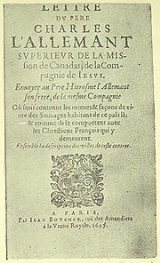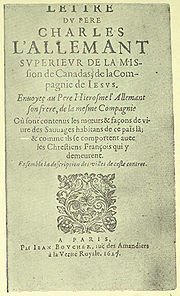
Charles Lallemant
Encyclopedia

France
The French Republic , The French Republic , The French Republic , (commonly known as France , is a unitary semi-presidential republic in Western Europe with several overseas territories and islands located on other continents and in the Indian, Pacific, and Atlantic oceans. Metropolitan France...
in 1625 as the first superior of the Jesuit missions in Canada
Canada
Canada is a North American country consisting of ten provinces and three territories. Located in the northern part of the continent, it extends from the Atlantic Ocean in the east to the Pacific Ocean in the west, and northward into the Arctic Ocean...
. His letter to his brother, dated 1 August 1626, inaugurated the series Relations des Jésuites de la Nouvelle-France
Relations des Jésuites de la Nouvelle-France
The Jesuit Relations, also known as The Relations des Jesuites de la Nouvelle-France, are early ethnographic documents that chronicle Jesuit missions in New France...
about the missionary work in that country.
Biography
Thwarted by the Trading Company at QuebecQuebec
Quebec or is a province in east-central Canada. It is the only Canadian province with a predominantly French-speaking population and the only one whose sole official language is French at the provincial level....
in his efforts to evangelize the Indians, Lallemant
Lallemant
Lallemant is a French surname that may originate in the phrase "l’Allemand", meaning "the German." Variants of the name include: Laleman, Lalemand, Lalemant, Lalleman, L'allemand, and Lallemand.It may refer to:-Persons:...
went to France to protest. Attempting to return to America, his vessel was captured by Kirke
David Kirke
Sir David Kirke was an adventurer, colonizer and governor for the king of England. Kirke was the son of Gervase Kirke, a wealthy London-based Scottish merchant, who had married a Huguenot woman, Elizabeth Goudon, and was raised in Dieppe, in Normandy.In 1627 Kirke's father and several London...
who was then blockading the Saint Lawrence River
Saint Lawrence River
The Saint Lawrence is a large river flowing approximately from southwest to northeast in the middle latitudes of North America, connecting the Great Lakes with the Atlantic Ocean. It is the primary drainage conveyor of the Great Lakes Basin...
. Lallemant was sent as a prisoner to England
England
England is a country that is part of the United Kingdom. It shares land borders with Scotland to the north and Wales to the west; the Irish Sea is to the north west, the Celtic Sea to the south west, with the North Sea to the east and the English Channel to the south separating it from continental...
. A second attempt to travel to America resulted in shipwreck off Cape Canso
Canso, Nova Scotia
For the headland, see Cape Canso.Canso is a small Canadian town in Guysborough County, on the north-eastern tip of mainland Nova Scotia, next to Chedabucto Bay. The area was established in 1604, along with Port Royal, Nova Scotia. The British construction of a fort in the village , was instrumental...
, and on his way back to France he was wrecked a second time on the coast of Spain
Spain
Spain , officially the Kingdom of Spain languages]] under the European Charter for Regional or Minority Languages. In each of these, Spain's official name is as follows:;;;;;;), is a country and member state of the European Union located in southwestern Europe on the Iberian Peninsula...
. He finally reached America in 1632 after Quebec was restored to the French. He was the friend and confessor of Samuel de Champlain
Samuel de Champlain
Samuel de Champlain , "The Father of New France", was a French navigator, cartographer, draughtsman, soldier, explorer, geographer, ethnologist, diplomat, and chronicler. He founded New France and Quebec City on July 3, 1608....
, who died in his arms.
He returned again to France in 1638, where he became procurator of the Canadian missions, vice provincial and superior of the "Professed house
Professed House (Paris)
The Professed House was a Jesuit professed house in Paris, built on the rue Saint-Antoine in Le Marais. Its site between rue Saint-Paul, rue Saint-Antoine and rue Charlemagne are now occupied by the lycée Charlemagne. It welcomed theologians and scientists and was in a quarter lived in by the...
" in Paris. He obtained the concession of the Island of Montreal
Island of Montreal
The Island of Montreal , in extreme southwestern Quebec, Canada, is located at the confluence of the Saint Lawrence and Ottawa Rivers. It is separated from Île Jésus by the Rivière des Prairies....
for the colony of Dauversière
Jerome le Royer de la Dauversiere
Jérôme le Royer de la Dauversière was a Jesuit who was head of the Société Notre-Dame de Montréal.- Youth :...
, and he also recruited Maisonneuve
Paul Chomedey de Maisonneuve
Paul de Chomedey, sieur de Maisonneuve was a French military officer and the founder of Montreal.- Early career :...
and Jeanne Mance
Jeanne Mance
Jeanne Mance was a French settler of New France. She was one of the founders of Montreal who secured its survival and was the founder and head of the Hôtel-Dieu de Montréal.-Origins:...
to engage in the undertaking. When there was question of appointing the first Bishop of Quebec
Bishop of Quebec
The title Bishop of Quebec refers to more than one individual:* The Anglican Bishop of Quebec* The Roman Catholic Archbishop of Quebec- See also :* Bishop of Calgary * Bishop of Edmonton...
, his candidacy was urged.
Lallemant was the author of a spiritual work entitled La vie cachée de Notre Seigneur Jésus-Christ.
He is not to be confused with Louis Lallemant
Louis Lallemant
Louis Lallemant was a French Jesuit.After making his studies under the Fathers of the Society of Jesus, Lallemant entered that order in 1605, having completed the usual course of study and teaching for new members...
, author of Les Conferences Spirituelles.
Lallemant had two close relatives in the Jesuit missions: Jérôme Lalemant
Jérôme Lalemant
Jérôme Lalemant was a Jesuit priest who came to Canada in 1638 after much varied experience in the priesthood in France. He was almost immediately made superior for the mission to the Hurons, succeeding Jean de Brébeuf, and in 1639 founded Sainte-Marie-des-Hurons which was the central residence...
, his brother, and Gabriel Lallemant
Gabriel Lallemant
Saint Gabriel Lalemant was a Jesuit missionary and one of the eight Canadian Martyrs....
, a nephew.
External links
Original Sources
T.J. CAMPBELLTranscribed by Joseph E. O'Connor

